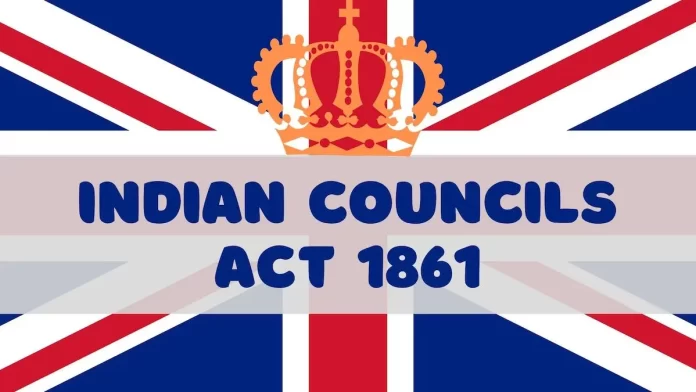The Indian Councils Act of 1861 was an important milestone in the constitutional and legal history of India. Read this to learn more about its background, salient features, and criticism.
Background
After the revolt of 1857, the British Government tried to shed its stoic attitude towards Indians by taking them into confidence in the law-making processes.
It felt the need of seeking the cooperation of the Indians in the administration of their country.
At the same time, it also aimed to entrench British rule more strongly to firmly deal with potential 1857 like rebellions.
Pursuant to this policy of association and firm control, the British Government enacted the three Councils Acts in the year 1861, 1892, and 1909.
While moving the Indian Councils Bill of 1861 in British Parliament, the Secretary of State for India, Charles Wood, said, “all experience teaches us that where a dominant race rules another, the mildest form of Government is despotism”.
Later he wrote to Elgin, the Indian viceroy, that the only government suitable for the Indian scenario is a despotism controlled from home.
Features of Indian Councils Act 1861
Some salient features of the Indian Councils Act 1861 include the following-
Representative Institutions
The Indian Councils Act 1861 marked the beginning of representative institutions by associating Indians with the law-making process.
It thus provided that the viceroy should nominate some Indians as non-official members of his expanded council.
In 1862, Lord Canning, the then viceroy, nominated three Indians to his legislative council – the Raja of Benaras, the Maharaja of Patiala, and Sir Dinkar Rao.
Decentralization and Legislative devolution
The Indian Councils Act 1861 initiated a process of decentralization and devolution of legislative powers by restoring the legislative powers to the Bombay and Madras Presidencies.
It thus reversed the centralizing tendency that started from the Regulating Act of 1773 and reached its climax under the Charter Act of 1833.
This policy of legislative devolution resulted in the grant of almost complete internal autonomy to the provinces in 1937.
Imperial Legislative Council
The Indian Councils Act of 1861 enlarged the Governor- General’s Executive Council for the purpose of making laws.
The Governor-General could now add from six to twelve members to the Executive Council.
At least half of these nominations had to be non-officials, Indian or British. This council came to be known as the Imperial Legislative Council.
However, in reality, the council possessed no power.
Provincial Legislative Councils
It also provided for the establishment of new legislative councils for Bengal, North-Western Frontier Province, and Punjab, which were established in 1862, 1866, and 1897 respectively.
It empowered the Viceroy to make rules and orders for the more convenient transaction of business in the council.
Portfolio System
Indian Councils Act 1861 also gave statutory recognition to the portfolio system, introduced by Lord Canning in 1859.
Under this, a member of the Viceroy’s council was made in charge of one or more departments of the government and was authorized to issue final orders on behalf of the council on matters of his departments.
Ordinances
The Act empowered the Indian Viceroy to issue ordinances, without the concurrence of the legislative council, during an emergency. The life of such an ordinance was six months.
Criticism
Many of the political and legislative reforms initiated by the Council Act were only for namesake. For instance, the Imperial Legislative Council hardly possessed any effective power.
Without the previous approval of the Viceroy, it could not discuss the budget, financial measure, or any other important bill.
Further, it could not even discuss the actions of the administration. It could not, therefore, be seen as some kind of parliament, even of the most elementary kind.
According to Bipin Chandra, the Council met, on average, for only twenty-five days in a year till 1892.
Sources
- Bipin Chandra, History of Modern India
- M. Laxmikant, Indian Polity
- Rajiv Ahir, A Brief History of Modern India
